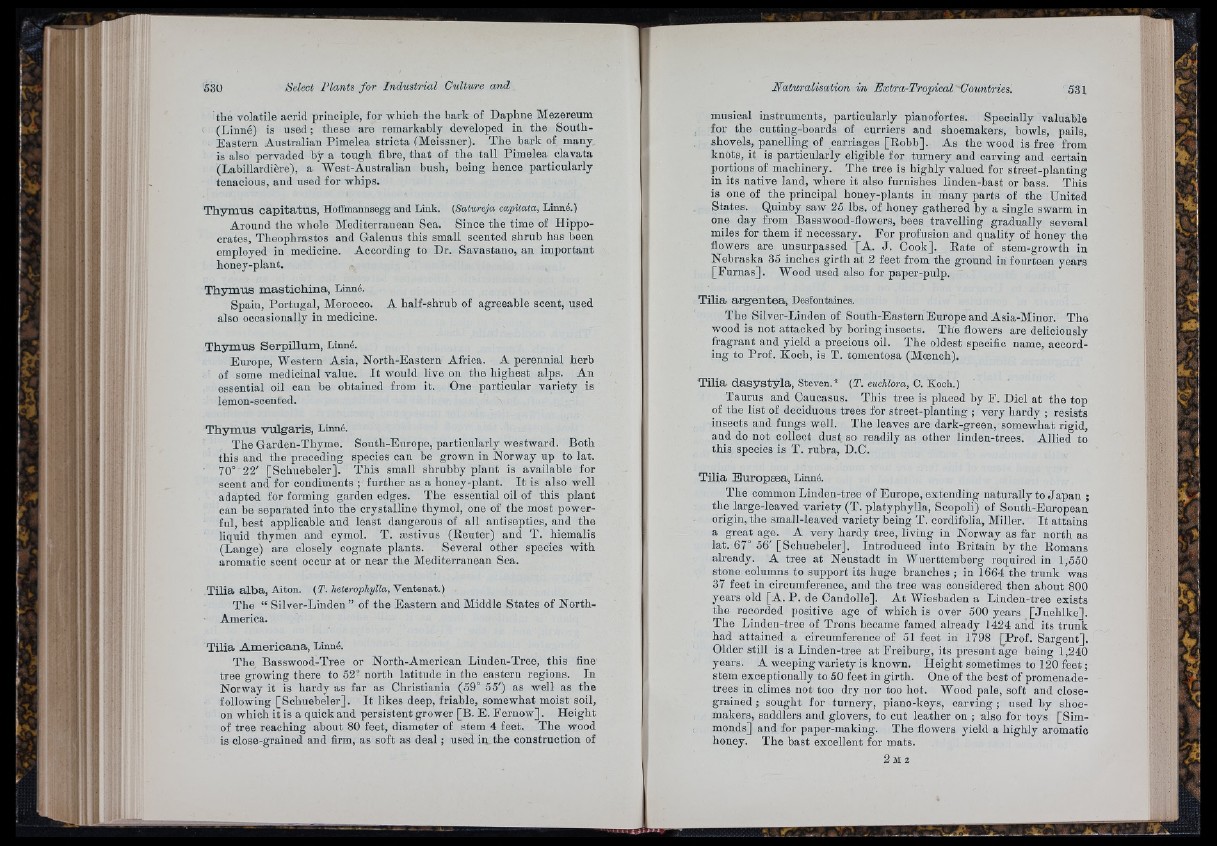
: i i
t
/'
Ì"
ii:L
the volatile acrid principle, for which the bark of Daphne Mezereum
(Linné) is used ; these are remarkably developed in the South-
Eastern Australian Pimelea stricta (Meissner). The bark of many
is also pervaded by a tough fibre, th a t of the ta ll Pimelea clavata
(Labillardière), a West-Australian bush, being hence particularly
tenacious, and used for whips.
T h y m u s c a p i t a t u s , Hoffmannsegg and Link. (Satureja capitata, Linné.)
Around the whole Mediterranean Sea. Since the time of Hippocrates,
Tlieopiirastos and Galenus this small scented shrub has been
employed in medicine. According to Dr. Savastano, an important
honey-plant.
T h y u n u s m a s ti c h in a , Linné.
Spain, Portugal, Morocco. A half-shrub of agreeable scent, used
also occasionally in medicine.
T h y m u s S e rp illum , Linné.
Europe, Western Asia, North-Eastern Africa. A perennial herb
of some medicinal value. I t would live on the highest alps. An
essential oil can be obtained from it. One particular variety is
lemon-scented.
T h y m u s v u lg a r is , Linné.
The Garden-Thyme. South-Europe, particularly westward. Both
this and the preceding species can he grown in Norway up to lat.
70° 22' [Schuebeler]. This small shrubby plant is available for
scent and for condiments ; further as a honey-plant. I t is also well
adapted for forming garden edges. The essential oil of this plant
can be separated into the crystalline thymol, one of the most powerful,
best applicable and least dangerous of all antiseptics, and the
liquid thymen and cymol. T. æstivus (Reuter) and T. hiemalis
(Lange) are closely cognate plants. Several other species with
aromatic scent occur at or near the Mediterranean Sea.
T ilia a lb a , Aiton. (T. heterophylla, Yentenat.)
The “ Silver-Liuden ” of the Eastern aud Middle States of North-
America.
T ilia A m e r ic a n a , Linné.
The Basswood-Tree or North-American Linden-Tree, this fine
tree growing there to 52° north latitude in the eastern regions. In
Norway it is hardy as far as Christiania (59° 55') as well as the
following [Schuebeler]. I t likes deep, friable, somewhat moist soil,
on which it is a quick and persistent grower [B. E. Fernow]. Height
of tree reaching about 80 feet, diameter of stem 4 feet. The wood
is close-grained and firm, as soft as deal ; used in the construction of
musical instruments, particularly pianofortes. Specially valuable
for the cutting-boards of curriers and shoemakers, bowls, pails,
shovels, panelling of carriages [Robb]. As the wood is free from
knots, it is particularly eligible for turnery aud carving and certain
portions of machinery. The tree is highly valued for street-planting
in its native land, where it also furnishes linden-hast or bass. This
is one of the principal honey-plants in many parts of the United
States. Quinby saw 25 Ihs. of honey gathered by a single swarm in
one day from Basswood-flowers, bees travelling gradually several
miles for them if necessary. For profusion and quality of honey the
flowers are unsurpassed [A. J . Cook]. Rate of stem-growth in
Nebraska 35 inches girth at 2 feet from the ground in fourteen years
[Fu rnas]. Wood used also for paper-pulp.
T ilia a r g e n t e a , Desfontaines.
The Silver-Linden of South-Eastern Europe and Asia-Minor. The
wood is not attacked by boring insects. The flowers are deliciously
fragrant and yield a precious oil. The oldest specific name, according
to Prof. Koch, is T. tomentosa (Moench).
T ilia d a s y s t y l a , Steven.* (T. eucUora, C. Koch.)
Taurus and Caucasus. This tree is placed by F. Diel at the top
of the list of deciduous trees for street-planting ; very hardy ; resists
insects and fungs well. The leaves are dark-green, somewhat rigid,
and do not collect dust so readily as other lindeu-trees. Allied to
this species is T. rubra, D.C.
T ilia E u r o p æ a , Linné.
The common Linden-tree of Europe, extending naturally to Jap an ;
the large-leaved variety (T. platyphylla, Scopoli) of South-European
origin, the small-leaved variety being T. cordifolia. Miller. I t attains
a great age. A very hardy tree, living in Norway as far north as
lat. 67° 56' [Schuebeler]. Introduced into Britain by the Romans
already. A tree at Neustadt in Wuerttemberg required in 1,550
stone columns to support its huge branches ; in 1664 the trunk was
37 feet in circumference, and the tree was considered tlien about 800
years old [A. P . de Candolle]. A t Wiesbaden a Linden-tree exists
the recorded positive age of which is over 500 years [Ju eh lk e ].
The Linden-tree of Trons became famed already 1424 and its trunk
had attained a circumference of 51 feet in 1798 [Prof. Sargent].
Older still is a Linden-tree a t Freiburg, its present age being 1,240
years. A weeping variety is known. Height sometimes to 120 feet ;
stem exceptionally to 50 feet in girth. One of the best of promenade-
trees in climes not too dry nor too hot. Wood pale, soft and close-
grained ; sought for turnery, piauo-keys, carving ; nsed by shoemakers,
saddlers and glovers, to cut leather on ; also for toys [Simmonds]
and for paper-making. The flowers yield a highly aromatic
honey. The bast excellent for mats.
.liL